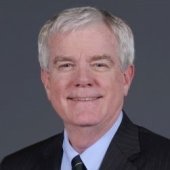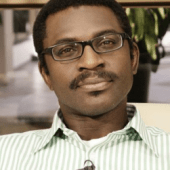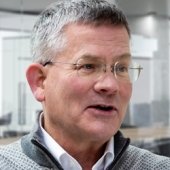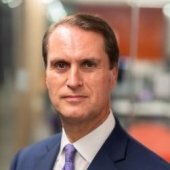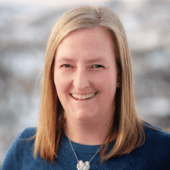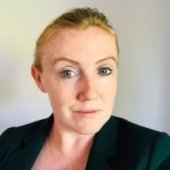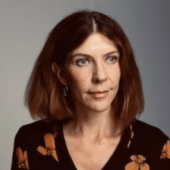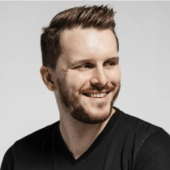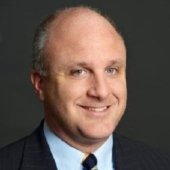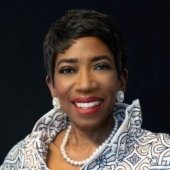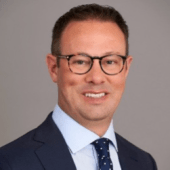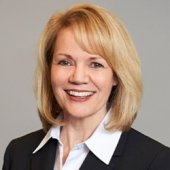IN BRIEF
- 2:09 - There’s a tendency for organizations to address too many sustainability topics that may or may not be relevant to their core business. Most organizations still think in terms of what, how and why. Good leaders will put the why first, hence the purpose statement. Building a culture of sustainability means embedding sustainability into a core business strategy.
- 12:32 - It’s really important for organizations to lean into their purpose and lean into their company values when big global events happen, and not necessarily be all things to all people, but be really clear as to who they are to their customers, who they are to their employees and who they are to their stakeholders. Organizations that do that will be very successful in 2030 and beyond.
- 14:45 - By 2035, we’ll see successful companies getting more right. And the other trend we’ll start to see is organic coalitions emerge. These coalitions will be groups of like-minded companies with more of a long-term perspective that shares that common culture of sustainability.
In this VISION by Protiviti podcast, Joe Kornik, Editor-in-Chief of VISION by Protiviti, sits down with Protiviti’s Fran Maxwell, Global Lead of the People Advisory and Organizational Change Segment, and Kim Lanier, Director with the People Advisory and Organizational Change segment, to discuss what steps business leaders should be taking to create a culture of sustainability at their organizations over the next decade, including what that entails, why it’s so important, and why the time to act is now.
Kimberly Lanier is a Director with the People Advisory and Organizational Change segment within the Business Performance Improvement practice at Protiviti where she is responsible for leading human capital reporting in HR transformation solutions. Kimberly has over 20 years of experience in HR performance and people analytics and has worked with many Fortune 500 global brands to quantify and amplify the value of their workforce.
Fran Maxwell is Global Lead of the People Advisory and Organizational Change segment within the Business Performance Improvement practice at Protiviti. Based in Phoenix, he brings more than 21 years of experience in human resources consulting. Before joining Protiviti, Fran held progressive leadership roles at Willis Towers Watson (previously Towers Watson), most recently as Managing Director – Market Leader and Client Management Leader.
Podcast transcript
Joe Kornik: Welcome to the VISION by Protiviti podcast. I’m Joe Kornik, Editor-in-Chief of VISION by Protiviti, a global content initiative looking into the future to examine big themes impacting the C-suite and executive boardrooms worldwide. Today, we’re exploring the future of ESG and its strategic implications for people, process and the planet and, specifically, how business leaders can create and foster a culture of sustainability at their organizations.
Today, I’m joined by two of my Protiviti colleagues to discuss what that means, how we get there and what the future holds. Joining me for the discussion today is Fran Maxwell, Global Lead of the People Advisory and Organizational Change segment, and Kim Lanier, Director with the People Advisory and Organizational Change segment. Fran and Kim, thank you so much for joining me on the podcast today.
Fran Maxwell: We’re excited to be with you, Joe.
Kim Lanier: Hey, Joe. It’s great to be here.
Joe Kornik: So, when we talk about this culture of sustainability, what does that entail, and why is that so important?
Fran Maxwell: As you probably are aware, there’s a lot in the market around environmental, social and governance—ESG—and what we think is that we’re at the infancy stage for organizations, developing what that looks like for them and embedding it into their overall culture. When we’re talking about culture, we’re talking about a set of behaviors that an organization tries to adhere to or tries to drive to. We believe a culture of sustainability is getting those things that drive your business from an environmental, social and governance perspective embedded into the fiber and the tissue of your organization. It’s just a part of how you do business, not necessarily something you need to think about.
Kim Lanier: To tag onto what Fran shared regarding a culture of sustainability, it entails developing a clear sense of direction by developing a statement of purpose in regard to ESG. That’s a great place to start. Purpose statements can be effective drivers of sustainability programs. They tend to home in on what is most important. There’s a tendency for organizations without that to address too many sustainability topics that may or may not be relevant to their core business. Most organizations still think in terms of what, how and why. Good leaders will put the why first, hence the purpose statement. Building a culture of sustainability means embedding sustainability into a core business strategy.
Joe Kornik: In general, how do you think most companies are doing in terms of building that culture of sustainability that you’re talking about, and do you think business leaders and boards recognize the importance of that?
Fran Maxwell: Joe, I’ll address your first question first. It’s challenging to come up with a generality, because organizations are all over the place. There are some organizations that are further along the maturity spectrum than others, that may have ESG metrics already built into leadership goals or individual goals. Those organizations are further along the spectrum as far as developing a culture of sustainability.
And then there are other organizations that are still trying to get their arms around what ESG means to them, like Kim mentioned. Maybe they’re doing too many things, or maybe they’re not doing the right things and they need to take a step back and figure out what direction they need to go. When we’re chatting with organizations, we often talk about starting at a materiality assessment so you can put a strong plan together in figuring out what’s important for your organization as it pertains to sustainability.
Joe Kornik: I feel like companies are at a pivot point right now in terms of the moment we’re in. Fran, you mentioned the different levels of maturity, what we just went through, and what we’re facing in the future, do you feel that too? What’s different about right now, and does that present any unique opportunities?
Fran Maxwell: One thing that’s different about right now is people are paying attention to this. Boards are, investors are. There’s a ton in media about it. We even see that as we’re interviewing candidates for positions—they’re asking about what our sustainability efforts are. What are we doing from the ESG perspective? What are our DEI programs? What do they look like? People—consumers and employees, or candidates—are paying attention. That’s what’s different, and that obviously drives board behavior and CEO behavior. If I were to highlight the difference, that’s the key component.
Kim Lanier: Increasingly, society is expecting companies to exist for more than just profit. They want them to contribute to that greater societal good, and that means taking care of people, communities and the planet. Society is driving this. Government is responding. And employees, especially millennials and Generation Z, want it. They want that sense of higher purpose connected to their work life. It’s rare that all these things converge at once. The key for the organization is not to get too political about it. It shouldn’t be a flavor-of-the-month approach. There’s a unique opportunity right now if we do this right and balance building a good business—profit, purpose and societal good all together—and take more of a long-term perspective.
Joe Kornik: And you both touched on this, but could you expand on it in terms of what needs to be in place for this culture of sustainability to exist and take root in an organization and flourish?
Fran Maxwell: Kim addressed a portion of it. It’s communicating the why: Why are we taking this on? I also think having a direction—understanding what’s important to you. The most important factor, though, is ensuring that the C-suite is modeling the behaviors that they expect from their people as it pertains to developing a culture of sustainability. We know that behaviors change and are modeled after leadership. Those leaders need to model these behaviors and recognize other folks that also share those behaviors and make it a priority for their leadership team to take these big initiatives on and be held accountable for them.
Joe Kornik: Let’s look out a bit into the future. What would you say are some of the key attributes to creating this culture of sustainability? Can you talk about what aspects of this can be addressed near-term and what ones may take longer for businesses to implement?
Kim Lanier: If I have to identify a few things, it would be the top four, as we talked about earlier: The mission, where there has to be a clear direction of purpose to establish a drive toward sustainability and ensure that the stakeholders and employees know how to align to the organization’s overall strategy and objectives. The second component would be consistency. There need to be systems and structures and processes established to support that so that it gets embedded into the organization, and the extent to which an organization can define the values and systems would form the basis of a strong culture of sustainability.
The third component would be the involvement or activation, and this is where once the system exists, it’s about involving and activating the workforce. This is asking a question: “Are our people aligned? Are they engaged?” It’s about getting them committed and owning and responsible for ESG and sustainability inside the organization. The fourth component would be being more adaptable. It’s about paying attention to trends and feedback from stakeholders, and it’s pausing and asking ourselves, “Are we listening to our key stakeholders? Are we listening to the marketplace?”
To address your question about what’s near-term and what’s longer-term, the near-term is creating a culture, setting that right foundation with mission and purpose. The other elements, like consistency and involvement, might take a little bit more of a longer-term view and involve resources from leadership to mature and make happen.
Fran Maxwell: Joe, I might add to what Kim said, and I believe it was in the foundation of what she said, but I’d like to call it out the measurement component: where you can measure the success of your ESG programs. You can see this most aptly, typically, in DEI programs, the diverse candidate pulls you’re bringing, or diverse hires, or those sorts of metrics. It’s important to have those KPIs or metrics in place—again, you're holding yourself accountable for meeting these standards.
What Kim said that I’ll underscore is, it’s probably important to revisit every so often at the board level. I don’t mean every year, but every two or three years. The culture of sustainability, and sustainability as a whole, is a journey. It’s not necessarily a destination, and that goes to Kim’s adaptability comment: We can’t just set our course and think that’s exactly going to be it. We have to be prepared and open to making some changes and some curves, and taking some left-hand turns when we don’t expect to.
Kim Lanier: I love the comment about measurement, Fran, and I want to stir up a caution flag, especially for companies that are just getting started: One of the common things for companies that are just getting started is to measure everything, to go crazy with the KPIs, and if you’re just starting out, it’s good to identify those few metrics that are key to your ESG mission and strategy, and then expand from there rather than getting so overwhelmed with so many different KPIs. It’s hard to pay attention to so many indicators. The more mature organizations will evolve to that point, but when you’re just getting started, it’s a good idea to keep it simple.
Joe Kornik: Great advice. I was going to ask you about some of the steps that business leaders should be taking. What advice would you give them to make sure that they’re on track for success in 2030 and beyond? The point of VISION by Protiviti is to look far into the future—a decade or more. There are a lot of near-term things they should be doing, but let’s focus more on those longer-term challenges. What advice would you give business leaders to make sure they get this right?
Kim Lanier: That’s a great question. My guidance would be to get the governance and accountability in place for the long term—to realize that it’s more of a marathon and less of a sprint. If you start with that foundation that we talked about earlier in having a good mission, coming back to that and making sure that those systems and processes are reinforcing that, and putting the energy and the resources into communicating to all your stakeholder groups and engaging them, those leading practices will set you up for success for the long term.
Fran Maxwell: I’d agree with Kim. I might be more philosophical in what organizations should do to make sure they’re successful in 2030 and beyond. It’s fair to say that trying times are going to continue to happen. Divisive things are going to happen in our world. We look at the war in Ukraine as one of those examples right now. Not that that’s divisive, but there’s a crisis there. It’s really important for organizations to lean into their purpose and lean into their company values when these big global events happen, and not necessarily be all things to all people, but be really clear as to who they are to their customers, who they are to their employees and who they are to their stakeholders. Organizations that do that will be very successful in 2030 and beyond.
Joe Kornik: Let’s stick on that 2030 theme, because the whole point of VISION by Protiviti, again, is that we like to bring in smart people and ask them questions about the future. I’m not going to let either of you get out of here without at least making a prediction or two. If I asked you to look out a decade or even more—let’s say 2035—where would you say we’d be? Are you optimistic that we’ll get this more right than wrong? When you forecast out, or when you think about 2035, what do you see?
Fran Maxwell: Joe, you’ll see the successful organizations get more right than wrong, because the organizations that are on the flip side and struggle, you’ll see consumers and employees vote with their feet. They’ll go elsewhere. They may be willing to pay a little extra money for a competitor that is more focused on sustainability or more focused on the environment. And we’ve already seen that trend happen, especially as Kim mentioned earlier, at the Gen Z and millennial levels. We’re at this unique time where the consumers and the employees are now requiring that organizations are held accountable to certain standards. That’s my opinion: In 2035, the folks who get this right will have more consumers and more talent wanting to come toward them.
Kim Lanier: Joe, both Fran and I are optimists by nature. I’m cautiously optimistic that we’re going to be in a good place. Companies will take some time to figure this out. By 2035, we’ll see, as Fran mentioned, successful companies getting more right. And the other trend we’ll start to see is organic coalitions emerge. These coalitions will be groups of like-minded companies with more of a long-term perspective that shares that common culture of sustainability.
The founder of the World Business Council for Sustainable Development coined a concept he called “practical partnerships for sustainability,” and we saw that with things like the total-quality movement way back in the day, where companies come together with practical partnerships from different sectors to combine skills and provide access to practices that one partner might not have. While he might have been ahead of his time when he predicted this would happen with ESG, the more it becomes mainstream and the more it becomes a regulatory requirement, the momentum is here—this will likely become more and more of a reality as more companies implement, have experience with and involve a lot of sustainability practices.
It makes sense that companies will come together. It’s mutually advantageous to share these leading practices, and what works, and how to overcome barriers. That’s the hope for the next 12 years.
Joe Kornik: I hope so as well. Well, thanks, Kim, and thanks, Fran. This was fun.
Fran Maxwell: We appreciate the opportunity.
Kim Lanier: Yes. Thank you. Great conversation.
Joe Kornik: And thank you for listening to the VISION by Protiviti podcast. Please rate and subscribe wherever you listen to podcasts, and be sure to visit us at Vision.Protiviti.com to keep up with our latest theme, the Future of ESG, and subscribe to sharpen your vision. For Fran and Kim, I’m Joe Kornik. We’ll see you next time.
Did you enjoy this content? For more like this, subscribe to the VISION by Protiviti newsletter.


